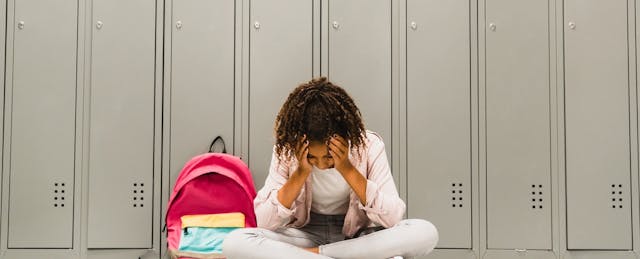LOS ANGELES — Tucked at the end of a hall in General Benjamin O. Davis Middle School in Compton is Room 105. Students know it as the “wellness center,” where they sometimes go for counseling sessions.
“A lot of people believe that it’s only adults who go through things in their lives,” says Neftalí Alcocer, a seventh grader at the school who’s used the center. “But I want to change that because I don’t think it’s right for parents to have that mentality about children.”
Concerns over student mental health have been high, especially since the pandemic, when anxiety and depression in K-12 students snowballed. It’s led to concerns over students’ well-being, as educators have noted depression, social-emotional problems and suicide attempts.
Straining under enormous pressure, students can feel isolated, unseen.
Parents in particular sometimes just don’t realize what their kids are actually going through until it’s too late, Neftalí says.
But some students feel that the wellness center is useful for regulating emotions.
About 50 to 75 students have received mental health services at the wellness center since it opened just before the pandemic, says Steven Nguyen, a school-based social worker who’s in charge of two wellness centers, including the one at Davis Middle School. (In all, there are 22 wellness centers in Compton Unified School District.)
“It has helped me in a lot of ways. Like, when I was going through something, the wellness center would help me deal and cope,” Neftalí explains from the hall outside of the wellness center.
Another student, an eighth grader named Sa’riya, agrees. “After a long Monday, with your head spinning around, you can do some yoga to clear your mind,” Sa’riya chimes in, pointing to a nearby room where they sometimes hold restorative circles and do yoga to help support students.
But while these school-based wellness centers can deliver some necessary health care, they’re relatively constrained. There are, after all, only so many social workers on staff and so many hours in the day.
Federal resources for K-12 mental health have increased, but many schools are still stretched thin. So the problem is one of both quality and quantity. And in Los Angeles County, of which Compton Unified School District is just one community, there are 1.3 million K-12 students.
District leaders think they’ve found a way to help: The Los Angeles County Office of Education announced last week that it’s offering K-12 students access to free telemedicine services.
That comes from a two-year $24 million agreement — funded through a state program — that now gives districts the option to make virtual therapy available to students, with the telehealth services being provided by the company Hazel Health.
Compton Unified is one of the districts which have chosen to opt in, meaning that students can now sign up for screenings and short sessions online, with those who need extra support sitting down for sessions with social workers, according to district leaders. Students can access these services from outside of school.
District leaders hope that a mix of longer-term therapy sessions — delivered through places like the wellness centers — and widely available telehealth services will bring mental health care within reach of the many students who may need it.
Early intervention can reduce the symptoms of the mental health crisis, said Debra Duardo, Los Angeles County superintendent of schools, at a press event announcing the partnership last Thursday.
In turning to telemedicine, the county isn’t alone.
These services say they’re a way to bring much-needed health care into schools while avoiding potentially sticky issuance issues. And this announcement came only a week after New York, the largest district in the country, announced a telehealth option for all high school students in the city.
Self-Perception Struggles
But having access to resources — or feeling that your district can deliver services — doesn’t guarantee that everyone will use them.
One of the barriers preventing more students from turning to the wellness center, says Nguyen, of Davis Middle School, is the perceptions of the students themselves.
How getting care for your mental health affects your reputation at school can vary, according to some students.
Sa’riya, the eighth grader, says that it’s “about 50-50” whether using the center tarnishes your reputation in the eyes of other students, or actually helps it.
“It goes both ways. Some people might feel better. Some people might look at you different, like, ‘oh, she must be unstable,’” Sa’riya says.
Some students don’t view themselves as having issues, or they perceive a stigma behind getting help, Nyguen says.
“Barriers are being broken down, but it’s still slow,” Nyguen says. “But progress is progress.”


